Volume 35, Issue 250 (11-2025)
J Mazandaran Univ Med Sci 2025, 35(250): 174-184 |
Back to browse issues page
Download citation:
BibTeX | RIS | EndNote | Medlars | ProCite | Reference Manager | RefWorks
Send citation to:



BibTeX | RIS | EndNote | Medlars | ProCite | Reference Manager | RefWorks
Send citation to:
Mazloomi N, Salehifar E, Karimzadeh L, Esfahanizadeh M, Ghezelsofla H, Khaleghi F et al . Policy Brief: Mechanisms and Guidelines for the Proper Management of Pesticide and Herbicide Use to Enhance the Health of Strategic Agricultural Products in Mazandaran Province. J Mazandaran Univ Med Sci 2025; 35 (250) :174-184
URL: http://jmums.mazums.ac.ir/article-1-21815-en.html
URL: http://jmums.mazums.ac.ir/article-1-21815-en.html
Narges Mazloomi 
 , Ebrahim Salehifar
, Ebrahim Salehifar 
 , Laleh Karimzadeh
, Laleh Karimzadeh 
 , Mohammadhosein Esfahanizadeh
, Mohammadhosein Esfahanizadeh 
 , Hashem Ghezelsofla
, Hashem Ghezelsofla 
 , Fatemeh Khaleghi
, Fatemeh Khaleghi 
 , Adele Rafati
, Adele Rafati 


 , Ebrahim Salehifar
, Ebrahim Salehifar 
 , Laleh Karimzadeh
, Laleh Karimzadeh 
 , Mohammadhosein Esfahanizadeh
, Mohammadhosein Esfahanizadeh 
 , Hashem Ghezelsofla
, Hashem Ghezelsofla 
 , Fatemeh Khaleghi
, Fatemeh Khaleghi 
 , Adele Rafati
, Adele Rafati 

Abstract: (503 Views)
Since the rapidly increasing global demand for food driven by population growth poses a potential threat to food safety and security, ensuring an adequate supply of safe and nutritious food has become a pressing global concern. Despite the widespread and often necessary use of pesticides to enhance agricultural production, pests continue to be one of the major factors causing crop damage and threatening food security. In order to promote the safe and effective use of pesticides and insecticides, this study aims to develop mechanisms and guidelines for their proper management, with the goal of enhancing the quality and safety of agricultural products in Mazandaran Province, particularly strategic crops such as rice and oranges. The study also seeks to monitor and control pesticide consumption levels in agricultural products and minimize associated risks, including health problems and diseases linked to pesticide and insecticide exposure. The Food and Drug Adiminstration of Mazandaran University of Medical Sciences, in collaboration with the Research Center for the Health of Plant and Animal Products at the same university, has regulated the use of chemical pesticides in the province’s agricultural products, particularly in strategic crops such as rice and oranges, with the aim of controlling pesticide consumption and reducing potential health and environmental risks. Considering the current emphasis on reducing pesticide use and promoting alternative, controlled cultivation management practices, the ongoing goal of this research and the relevant authorities is to guide agricultural production toward more sustainable and regulated farming systems through farmer education and support in subsequent stages. This approach aims to contribute significantly to improving human health, preserving the environment, reducing pesticide-related costs, and lowering the incidence of diseases associated with pesticide and insecticide exposure.
Type of Study: Research(Original) |
Subject:
Policy and Management
Send email to the article author
| Rights and permissions | |
 |
This work is licensed under a Creative Commons Attribution-NonCommercial 4.0 International License. |





